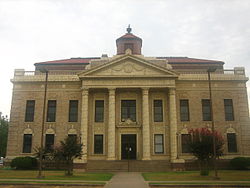Red River Parish is named for the Red River, part of the Mississippi River Watershed, which runs the length of this parish. This area was first settled by an expedition of Jefferson's Red River Exploring party in 1806. By the mid 1800s, the area flooded with pioneers from the overpopulated and over cultivated South. Red River Parish was officially created in 1871 by the legislature as part of Reconstruction. It was created from parts of Bienville, Bossier, Caddo, Desoto and Natchitoches Parishes. As settlement increased, so did steamboat traffic on the Red River. The Red River was the main method of transporting goods and people along cities that dotted the river's banks until the railroad moved in during the 1900s.
This area was first settled by an expedition of Jefferson's Red River Exploring party in 1806. By the mid 1800s, the area flooded with pioneers from the overpopulated and over cultivated South. Red River Parish was officially created in 1871 by the legislature as part of Reconstruction. It was created from parts of Bienville, Bossier, Caddo, Desoto and Natchitoches Parishes. As settlement increased, so did steamboat traffic on the Red River. The Red River was the main method of transporting goods and people along cities that dotted the river's banks until the railroad moved in during the 1900s.
Coushatta, the parish seat, is named after the Coushatta Indian tribe who once inhabited this area after being forced from Alabama and Georgia by European settlers. Coushatta is well known for the Coushatta Massacre, part of the overthrow of Radical Reconstruction in Louisiana. In August of 1874, the White League (a paramilitary organization of Southern Democrats) attacked Republican office holders and freedman witnesses, forced the officials to resign and then killed ten men.
Though Red River Parish is one of the smallest parishes, it is well known for its fertile lands. Before the Civil War, the parish was a plantation economy, heavily dependent on slave labor. In fact, the black population was double the white population in the 1800s. In the late 1800s, the main cash crops grown were cotton and corn as well a sweet potatoes and sugar cane. After the devastation the Civil War brought to the area, this parish continued to grow cash crops. However, the large plantations disappeared and the land was broken up for sharecroppers. Today, of the 386 square miles of the parish, 165 square miles are bottomlands with the rest being oak uplands. The uplands divide the Grand Bayou of Black Lake and the Red River. The area is still rich in natural resources. Comprising of more than 50,000 acres, the Red River National Refuge is doing a great deal to preserve the natural areas along the Red River.